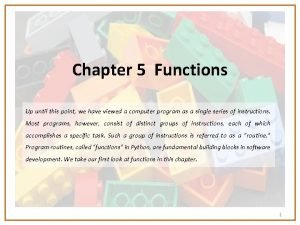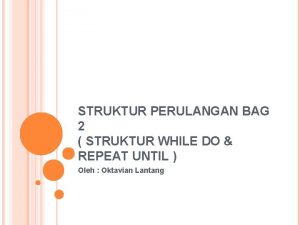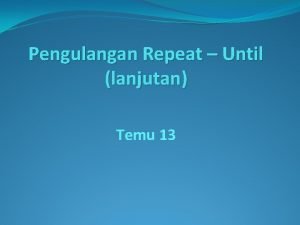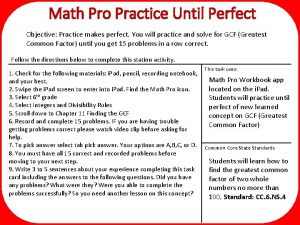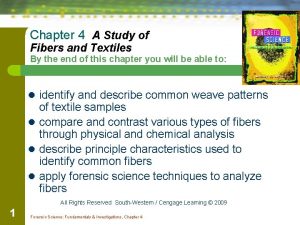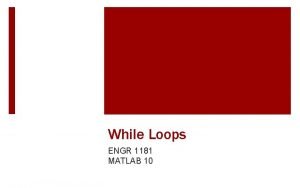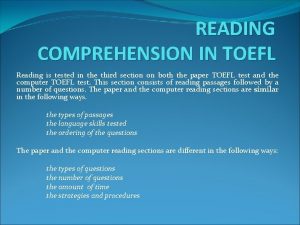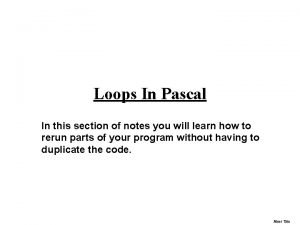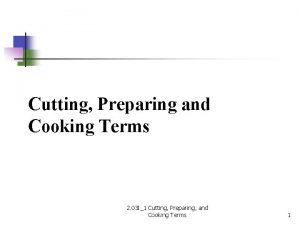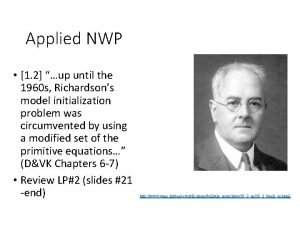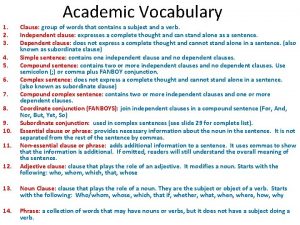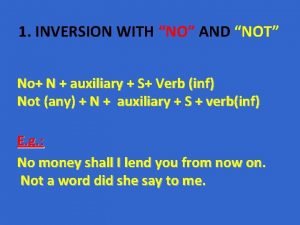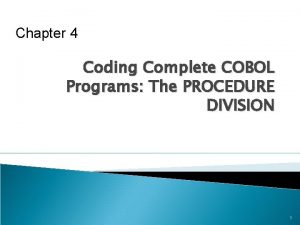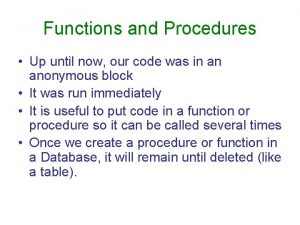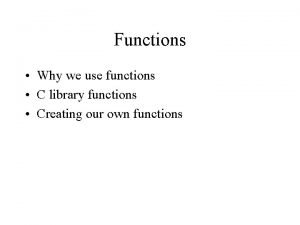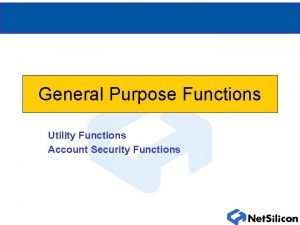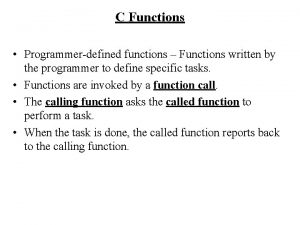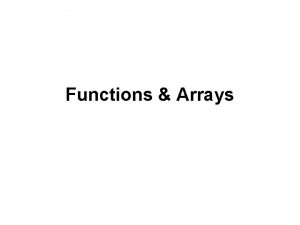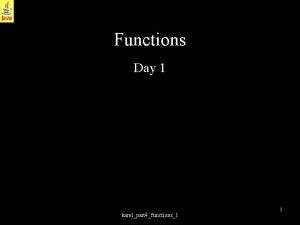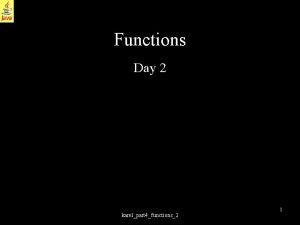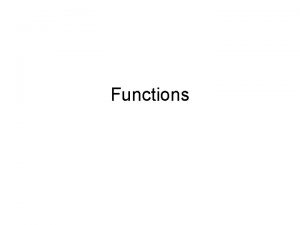Chapter 5 Functions Up until this point we
















































- Slides: 48

Chapter 5 Functions Up until this point, we have viewed a computer program as a single series of instructions. Most programs, however, consist of distinct groups of instructions, each of which accomplishes a specific task. Such a group of instructions is referred to as a “routine. ” Program routines, called “functions” in Python, are fundamental building blocks in software development. We take our first look at functions in this chapter. 1

Program Routines We first introduce the notion of a program routine. We then look at program routines in Python, called functions. We have already been using Python’s built-in functions such as len, range, and others. We now look more closely at how functions are used in Python, as well as how to define our own. 2

What is a Function Routine? A routine is a named group of instructions performing some task. A routine can be invoked (called) as many times as needed in a given program 3

Routine A. Call to Routine A. . When a routine terminates, execution automatically returns to the point from which it was called. Such routines may be predefined in the programming language, or designed and implemented by the programmer. A function is Python’s version of program routine. 4

Defining Functions • A function header starts with the keyword def, followed by an identifier (avg), which is the function’s name. • The function name is followed by a comma-separated (possibly empty) list of identifiers (n 1, n 2, n 3) called formal parameters, or simply “parameters. ” Following the parameter list is a colon ( : ). • Following the function header is the function body, a suite (program block) containing the function’s instructions. As with all suites, the statements must be indented at the same level, relative to the function header. 5

The number of items in a parameter list indicates the number of values that must be passed to the function, called actual arguments (or simply “arguments”), such as variables num 1, num 2, and num 3 below. Functions are generally defined at the top of a program. However, every function must be defined before it is called. 6

Value-Returning Functions A value-returning function is a program routine called for its return value, and is therefore similar to a mathematical function, e. g. , f(x) = 2 x In this notation, “x” stands for any numeric value that function f may be applied to, f(2) = 2 x 2 = 4 Program functions are similarly used. 7

Function avg takes three arguments (n 1, n 2, and n 3) and returns the average of the three. The function call avg(10, 25, 16), therefore, is an expression that evaluates to the returned function value. This is indicated in the function’s return statement of the form return expr, where expr may be any expression. 8

Let’s Try It From the Python Shell, first enter the following function, making sure to indent the code as given. Hit return twice after the last line of the function is entered. Then enter the following function calls and observe the results. 9

Non-Value-Returning Functions A non-value-returning function is called not for a returned value, but for its side effects. A side effect is an action other than returning a function value, such as displaying output on the screen. 10

Let’s Try It From the Python Shell, first enter the following function, making sure to indent the code as given. Then enter the following function calls and observe the results. 11

Function Calls Overview • A call to a value-returning function is an expression. It evaluates to the value returned by the function call. Thus, calls to value-returning functions are made part of a larger expression or instruction, result = avg(10, 25, 16) * factor • A call to a non-value-returning function is a statement. Thus, calls to non-value-returning functions are written as a statement (instruction) on its own, display. Welcome() • Technically, all functions in Python are value-returning, since functions that do not return a value return special value None. 12

Let’s Apply It Temperature Conversion Program The following is a program that allows a user to convert a range of values from Fahrenheit to Celsius, or Celsius to Fahrenheit, as presented in Chapter 3. In this version, however, the program is designed with the use of functions. This program utilizes the following programming features. ➤ value-returning functions ➤ non-value-returning functions From To Fahrenheit To Celsius Fahrenheit (F) F (F - 32) * 5/9 Celsius (C or o) (C * 9/5) + 32 C

More on Functions We further discuss issues related to function use, including more on function invocation and parameter passing. 14

Calling Value-Returning Functions Calls to value-returning functions can be used anywhere that a function’s return value is appropriate, result = max(num_list) * 100 15

Other examples of calls to value-returning functions. (a) (b) (c) (d) Expressions containing multiple function calls Function call as an argument to another function call Function call as conditional expression Function call as part of calls to built-in print function 16

A value-returning function may return more than one value by returning the values as a tuple. (a) Assigns the returned tuple to variable highlow_temps (b) Uses tuple assignment to assign both variables high and low 17

Let’s Try It Enter the definitions of functions avg and minmax given above. Then enter the following function calls and observe the results. 18

Calling Non-Value-Returning Functions Calls to non-value-returning functions are for the sideeffects produced, and not for a returned function value, such as displaying output on the screen, display. Welcome() It does not make any sense to treat this function call as an expression, welcome_displayed = display. Welcome() 19

Functions Designed to Take No Arguments As shown in the previous examples, both value-returning and non -value-returning functions can be designed to take no arguments. 20

Let’s Try It Enter the definition of function hello given below, then enter the following function calls and observe the results. 21

Parameter Passing Parameter passing is the process of passing arguments to a function. Recall that actual arguments are the values passed to a function’s formal parameters to be operated on. 22

The correspondence of actual arguments and formal parameters is determined by the order of the arguments passed, and not their names. 23

The following parameter passing is perfectly valid. It is fine to pass actual arguments num 1 and num 2 to function ordered as shown (either num 1 as the first argument, or num 2 as the first) 24

Let’s Try It Enter the definition of function ordered given above into the Python Shell. Then enter the following and observe the results. 25

Mutable vs. Unmutable Arguments There is an issue related to parameter passing not yet considered. If a function changes the value of any of its formal parameters, does that change the value of the corresponding actual argument passed? 26

When literals are passed as arguments, there is no issue. It is when the actual arguments are variables that this must be considered. 27

Since function avg does not change the value of its parameters, the corresponding actual parameters num 1, num 2 and num 3 will not be altered. 28

Consider, however, the following function. This function simply displays a countdown of the provided integer parameter value. For example, function call count. Down(4) produces the following output, 29

What if the function call contained a variable as the argument, for example, count. Down(num_tics)? Since function count. Down alters the value of formal parameter n, decrementing it until it reaches the value − 1, does the corresponding actual argument num_tics have value − 1 as well? If you try it, you will see that variable num_tics is left unchanged. 30

Now consider the following function. Function sum. Pos returns the sum of only the positive numbers in the provided argument (list). It does this by first replacing all negative values in parameter nums with 0, then summing the list using built-in function sum. We see that the corresponding actual argument nums_1 has been altered in this case, with all of the original negative values set to 0. The reason that there was no change in integer argument num_tics but there was in list argument nums_1 has to do with their types. 31

Immutable Numeric Types (integers and floats) Lists Boolean Type Dictionaries (not yet introduced) String Type Tuples 32

Let’s Try It Enter the following and observe the results. 33

Keyword Arguments in Python The functions we have looked at so far were called with a fixed number of positional arguments. A positional argument is an argument that is assigned to a particular parameter based on its position in the argument list, 34

Python provides the option of calling any function by the use of keyword arguments. A keyword argument is an argument that is specified by parameter name, rather than as a positional argument. This can be a useful way of calling a function if it is easier to remember the parameter names than it is to remember their order. 35

It is possible to call a function with the use of both positional and keyword arguments. However, all positional arguments must come before all keyword arguments in the function call, as shown below. This form of function call might be useful, for example, if you remember that the first argument is the loan amount, but you are not sure of the order of the last two arguments rate and term. 36

Let’s Try It Enter the following function definition in the Python Shell. Execute the statements below and observe the results. 37

Default Arguments in Python provides for default arguments. A default argument is an argument that can be optionally provided. Parameter term is assigned a default value, 20, and therefore is optionally provided when calling function mortgage_rate. All positional arguments must come before any default arguments in a function definition. 38

Let’s Try It Enter the following function definition in the Python Shell. Execute the statements below and observe the results. 39

Variable Scope Variable scope has to do with the parts a program that a given variable is accessible. 40

Local Scope and Local Variables A local variable is a variable that is only accessible from within a given function. Such variables are said to have local scope. In Python, any variable assigned a value in a function becomes a local variable of the function. 41

Both func 1 and func 2 contain identifier n. Function func 1 assigns n to 10, while function func 2 assigns n to 20. Both functions display the value of n when called—func 2 displays the value of n both before and after its call to func 1. If identifier n represents the same variable, then shouldn’t its value change to 10 after the call to func 1? The execution of func 2, however, shows that the value of n remains unchanged. 42

Now consider the following. In this case, when func 2 is called, we get an error that variable n is not defined within func 1. This is because variable n defined in func 2 is inaccessible from func 1. 43

Variable Lifetime The period of time that a variable exists is called its lifetime. Local variables are automatically created (allocated memory) when a function is called, and destroyed (deallocated) when the function terminates. Thus, the lifetime of a local variable is equal to the duration of its function’s execution. Consequently, the values of local variables are not retained from one function call to the next. 44

Let’s Try It Enter the following function definition in the Python shell. Execute the statements below and observe the results. 45

Global Variables and Global Scope A global variable is a variable that is defined outside of any function definition. Such variables are said to have global scope. 46

Variable max is defined outside func 1 and func 2, and therefore “global” to each. Thus, it is referred to as a global variable. As a result, it is directly accessible by both functions. The use of global variables is generally considered to be bad programming style. Although it provides a convenient way to share values among functions, all functions within the scope of a global variable can access and alter it. This may include functions that have no need to access the variable, but none-the-less may unintentionally alter it. Another reason that the use of global variables is bad practice is related to code reuse. If a function is to be reused in another program, the function will not work properly if it is reliant on the existence of global variables that are nonexistent in the new program 47

Let’s Apply It GPA Calculation Program The following program computes a semester GPA and new cumulative GPA for a given student. This program utilizes the following programming features: ➤ tuple assignment 48
 Python intrinsic functions
Python intrinsic functions Piecewise function absolute value
Piecewise function absolute value Evaluating functions
Evaluating functions Evaluating functions and operations on functions
Evaluating functions and operations on functions Last homework
Last homework Global climate is warming has been well documented
Global climate is warming has been well documented Until lambs become lions
Until lambs become lions Jelaskan tujuan perulangan 'repeat' digunakan.
Jelaskan tujuan perulangan 'repeat' digunakan. Rise and rise until lambs become lions
Rise and rise until lambs become lions Flowchart nested loop
Flowchart nested loop Program menghitung jumlah deret pecahan
Program menghitung jumlah deret pecahan Contoh algoritma repeat until
Contoh algoritma repeat until Practice until perfect
Practice until perfect Till we meet at jesus feet
Till we meet at jesus feet Wordless book song
Wordless book song Cryptinject
Cryptinject What does a strike slip fault cause
What does a strike slip fault cause Employers must not place construction loads
Employers must not place construction loads Chapter 4 fibers and textiles
Chapter 4 fibers and textiles Do while loop matlab
Do while loop matlab Seligman dog experiment
Seligman dog experiment Raise and rise again until lambs become lions
Raise and rise again until lambs become lions Juan rodriguez cabrillo was a portuguese-born
Juan rodriguez cabrillo was a portuguese-born A brick sits on a table until you push it
A brick sits on a table until you push it A brick sits on a table until you push it
A brick sits on a table until you push it Entrepreneurs work until the job is done
Entrepreneurs work until the job is done We waited all through the year for the day to
We waited all through the year for the day to Second star to the right and straight on until morning
Second star to the right and straight on until morning Until lions have their historians
Until lions have their historians To daffodils by robert herrick poem analysis
To daffodils by robert herrick poem analysis Possessive quiz
Possessive quiz Repeat until pascal
Repeat until pascal Parvenau
Parvenau Cut into small uneven pieces
Cut into small uneven pieces Up until the 1960s
Up until the 1960s Quia conjunctions rags to riches
Quia conjunctions rags to riches Not inversion
Not inversion Praise until the spirit of worship comes
Praise until the spirit of worship comes All the way until the end
All the way until the end Conjunctions
Conjunctions Promotion valid until
Promotion valid until Stress that squeezes rock until it folds or breaks
Stress that squeezes rock until it folds or breaks Until this moment
Until this moment Do until vba
Do until vba Perform until cobol example
Perform until cobol example Designing a global sneaker
Designing a global sneaker A union b example
A union b example Lasted until 1914
Lasted until 1914 Point by point block method
Point by point block method
